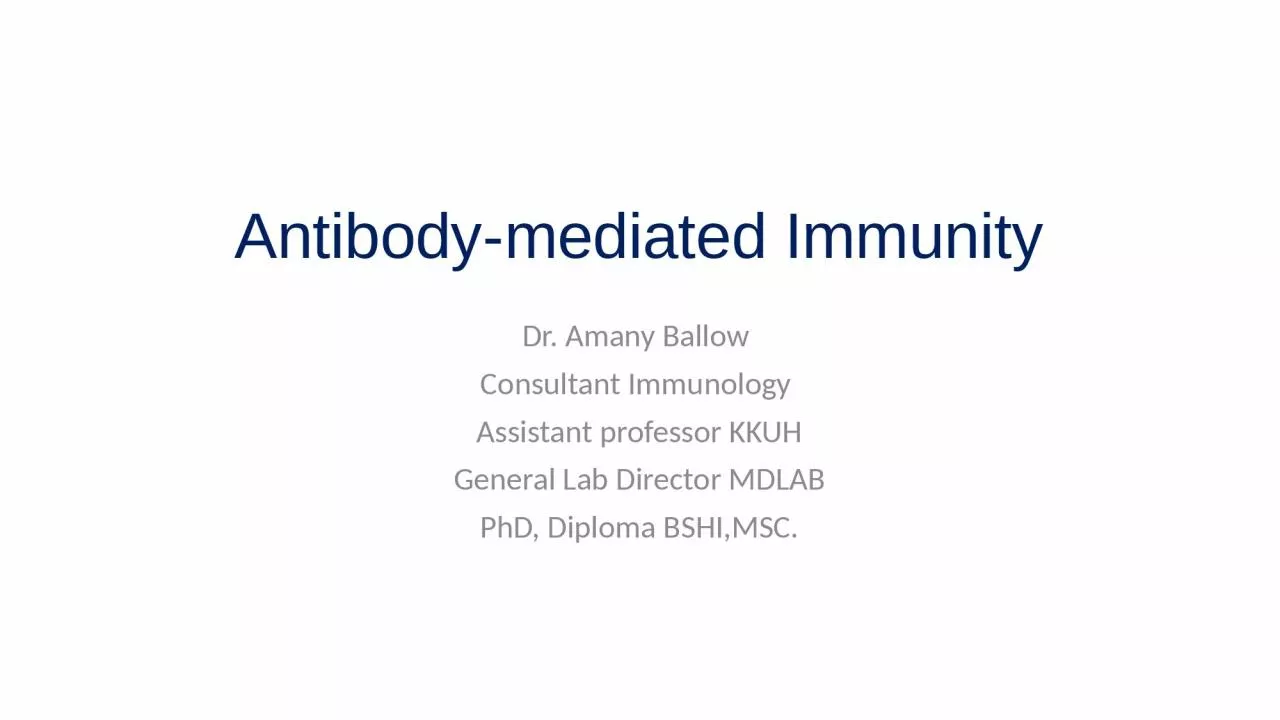

Dr Amany Ballow Consultant Immunology Assistant professor KKUH General Lab Director MDLAB PhD Diploma BSHIMSC Objectives To describe Bcells as the mediators of humoral immunity antibodymediated immunity ID: 1036418
Download Presentation The PPT/PDF document "Antibody-mediated Immunity" is the property of its rightful owner. Permission is granted to download and print the materials on this web site for personal, non-commercial use only, and to display it on your personal computer provided you do not modify the materials and that you retain all copyright notices contained in the materials. By downloading content from our website, you accept the terms of this agreement.
1. Antibody-mediated ImmunityDr. Amany Ballow Consultant Immunology Assistant professor KKUHGeneral Lab Director MDLABPhD, Diploma BSHI,MSC.
2. Objectives To describe B-cells as the mediators of humoral immunity, (antibody-mediated immunity)2. To describe activation of B-cells which involve: -Antigen recognition -T-dependent & T-independent antigens - Requirement for T-helper cells3. To explain clonal selection, clonal expansion & generation of plasma cells & memory cells4. To describe primary & secondary immune responses 5. To describe the structure & function of Immunoglobulins
3. Humoral Immunity Humoral immunity is so named because it involves substances found in the humours or body fluidsThe Humoral Immune Response is the aspect of immunity that is mediated by secreted antibodies
4.
5. Activation of B cells by antigens1-T-dependent - Antibody production by B-cells require T-helper cells - Macrophages recognize antigen & present it to T-helper cells - T-helper cells stimulate B-cells specific for that antigen to become plasma cells - T-dependent antigens are mainly proteins on viruses, bacteria & other foreign materials.
6.
7.
8. Clonal selection and clonal proliferation
9. Activation of B-cells by antigens2-T-independent antigens B-cells do not require T-helper cells to produce antibody.Antigens are mainly polysaccharides or lipo-polysaccrides with repeating subunits example :bacterial capsule. 3. Immune responses are weak compared to T-dependent responses.
10. AntigensSelf” versus “non-self”T cells and B cells removed if they recognize self proteinsAntigens are mostly proteins or polysaccharides Antigenic determinants (epitopes)Each bacterial cell has many different epitopes
11. AntibodiesAntibodies are immunoglobulins (Ig) with specific functions.Antibodies are found in extracellular fluids (blood plasma, lymph, mucus, etc.) and the surface of B cells. Antibodies bind to specific sites on antigen surfaces and perform protective functions by different mechanisms.There is a specific antibody for each antigen stimulate the immune response.
12. Antibody function
13. Antibody structure and functionMade up of four polypeptides (amino acid chains).Two longer and larger (heavy chains ) and the other two shorter and smaller (light chains)Have the shape of a letter “Y”
14. Variable region has the potential to bind with particular classes of antigens. Once a raw antibody is stimulated to fit to a specific antigen, it can then react with ONLY that antigen .This is known as SINGLE SPECIFICITY Can fit as precisely as a lock-and-key to an antigen.Constant regions.Fc region (stem) - can bind complement
15.
16.
17. Antibody dependent cell-mediated cytotoxicityAntibodies coat infecting cell (large parasite usually) - FC facing outwardsNK (lysing ability), Macrophage, neutrophils, and eosinophils have receptors for FC region of antibodySecretion of lytic enzymes to destroy parasite
18. Concentration & type of antibody in primary & secondary immune responses
19. Comparison between primary & secondary responses
20. SummaryB cells can be activated by antigen to produce antibodies either with the assistance of helper T cells or directly by the antigen itselfAntibodies are made up of two heavy and two light amino acid chains and have a shape of letter “Y”Different types of antibodies are located at various sites to provide protection by agglutination, precipitation, complement fixation etc.Secondary humoral immune response is swift and a stronger immune response mediated by IgG class of antibodies because of the memory cells.